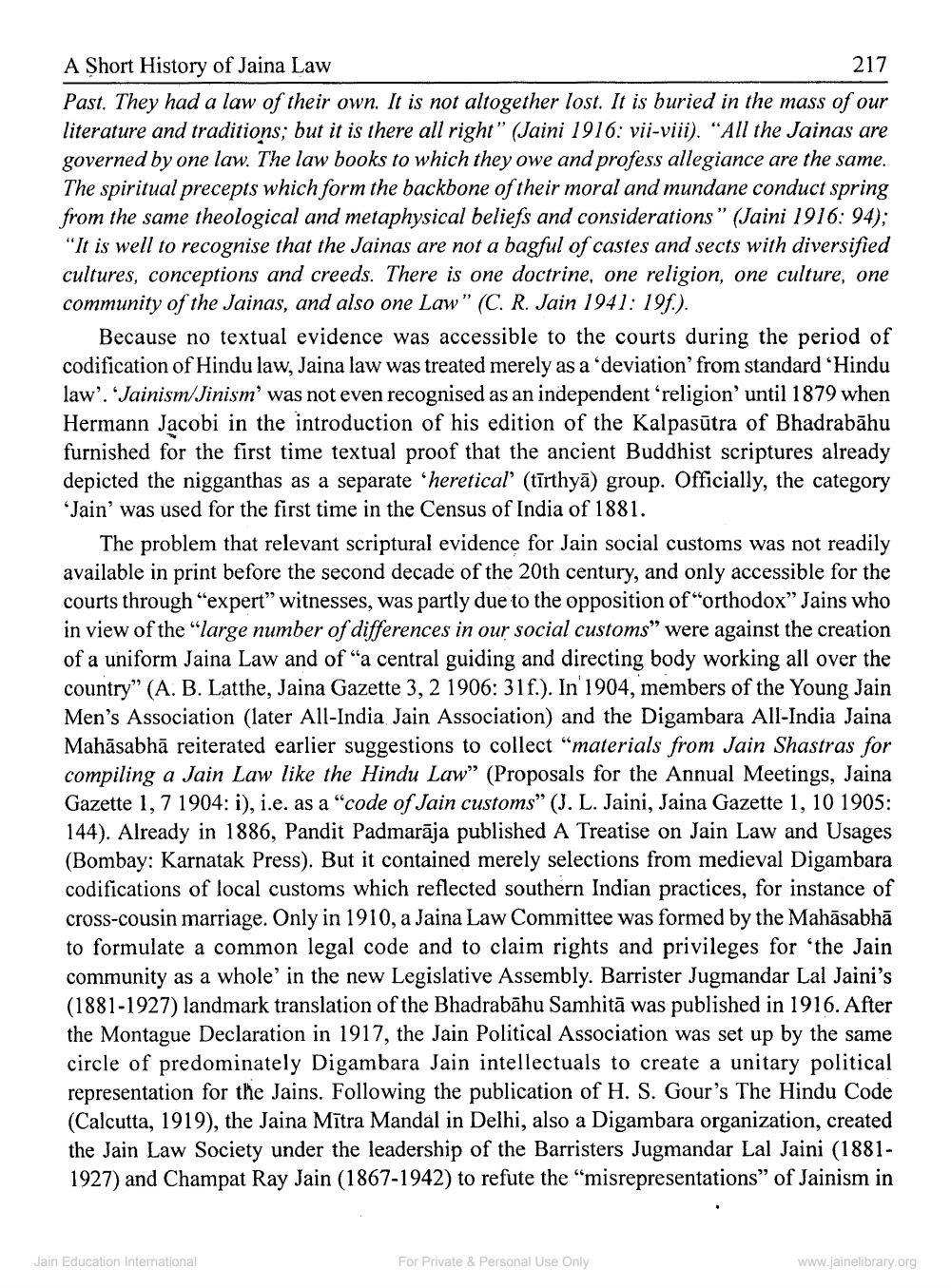________________
A Short History of Jaina Law
217
Past. They had a law of their own. It is not altogether lost. It is buried in the mass of our literature and traditions; but it is there all right" (Jaini 1916: vii-viii). "All the Jainas are governed by one law. The law books to which they owe and profess allegiance are the same. The spiritual precepts which form the backbone of their moral and mundane conduct spring from the same theological and metaphysical beliefs and considerations" (Jaini 1916: 94); "It is well to recognise that the Jainas are not a bagful of castes and sects with diversified cultures, conceptions and creeds. There is one doctrine, one religion, one culture, one community of the Jainas, and also one Law" (C. R. Jain 1941: 19f.).
Because no textual evidence was accessible to the courts during the period of codification of Hindu law, Jaina law was treated merely as a 'deviation' from standard 'Hindu law'. 'Jainism/Jinism' was not even recognised as an independent 'religion' until 1879 when Hermann Jacobi in the introduction of his edition of the Kalpasūtra of Bhadrabāhu furnished for the first time textual proof that the ancient Buddhist scriptures already depicted the nigganthas as a separate 'heretical' (tīrthyā) group. Officially, the category 'Jain' was used for the first time in the Census of India of 1881.
The problem that relevant scriptural evidence for Jain social customs was not readily available in print before the second decade of the 20th century, and only accessible for the courts through "expert" witnesses, was partly due to the opposition of “orthodox” Jains who in view of the "large number of differences in our social customs" were against the creation of a uniform Jaina Law and of "a central guiding and directing body working all over the country" (A. B. Latthe, Jaina Gazette 3, 2 1906: 31f.). In 1904, members of the Young Jain Men's Association (later All-India Jain Association) and the Digambara All-India Jaina Mahasabha reiterated earlier suggestions to collect "materials from Jain Shastras for compiling a Jain Law like the Hindu Law" (Proposals for the Annual Meetings, Jaina Gazette 1,7 1904: i), i.e. as a "code of Jain customs" (J. L. Jaini, Jaina Gazette 1, 10 1905: 144). Already in 1886, Pandit Padmarāja published A Treatise on Jain Law and Usages (Bombay: Karnatak Press). But it contained merely selections from medieval Digambara codifications of local customs which reflected southern Indian practices, for instance of cross-cousin marriage. Only in 1910, a Jaina Law Committee was formed by the Mahasabhā to formulate a common legal code and to claim rights and privileges for 'the Jain community as a whole' in the new Legislative Assembly. Barrister Jugmandar Lal Jaini's (1881-1927) landmark translation of the Bhadrabahu Samhita was published in 1916. After the Montague Declaration in 1917, the Jain Political Association was set up by the same circle of predominately Digambara Jain intellectuals to create a unitary political representation for the Jains. Following the publication of H. S. Gour's The Hindu Code (Calcutta, 1919), the Jaina Mitra Mandal in Delhi, also a Digambara organization, created the Jain Law Society under the leadership of the Barristers Jugmandar Lal Jaini (18811927) and Champat Ray Jain (1867-1942) to refute the "misrepresentations" of Jainism in
Jain Education International
For Private & Personal Use Only
www.jainelibrary.org




